Godzilla Raids Again (1955)
Directed by: Motoyoshi Oda
Written by: Shigeaki Hidaka, Shigeru Kayama, Takeo Murata
Starring: Hiroshi Koizumi, Minoru Chiaki, Setsuko Wakayama, Takashi Shimura
HCF REWIND NO.107. GODZILLA RAIDS AGAIN AKA GOJIRA NO GYAKUSHU, GIGANTIS THE FIRE MONSTER [Japan 1955]
AVAILABLE ON DVD AND BLU RAY
RUNNING TIME: 81 min/79 min [US version]
FEATURED MONSTERS: GODZILLA, ANGUIRUS
REVIEWED BY: Dr Lenera, Official HCF Critic
Two pilots named Tsukioka and Kobayashi are hunting for schools of fish for a tuna cannery company in Osaka. Kobayashi’s plane malfunctions and is forced to land on Iwato Island, an uninhabited strip of rocks formed by volcanic eruptions. Tsukioka looks for him and finds him safe, but then both men witness two giant monsters fighting, one of them Godzilla, before falling off a cliff into the ocean. The two report to the authorities in Osaka, and find out that the other monster Godzilla was fighting is Anguirus, who lived at the same time as Godzilla, though this new incarnation is a second member of the same species, it and Anguirus probably brought back to life by the same hydrogen bomb tests that awoke the original Godzilla. Dr Yamane states that there is no way to kill Godzilla, but the military could use flares on him to attract the monster away from the shore….
Toho had certainly hedged their bets by having Dr Yamane say there could be more Godzillas at the end of Godzilla. In 1933, a sequel called Son Of Kong had been hurriedly and cheaply rushed out because of the huge success of King Kong earlier that year. It seems that this wasn’t that different from the making and release of the second Godzilla movie, which found itself in Japanese cinemas only six months after the release of the original, and was also in black and white. I suppose that it would have been very hard to match the first movie, but Godzilla Raids Again is a significant drop in quality. On its own it’s still a solid monster effort, still serious in tone, and somewhat neglected because for ages it was hard to see and then only in its shoddy US edit, but it’s closer to American monster movies than probably any other kaiju picture except Rodan and therefore lacks most of the inventiveness and craziness of the Japanese monster movies to come while not having the power and intelligence of Godzilla either. It falls between two stools and seems somewhat compromised, while it’s also handicapped by odd pacing, but it’s still fun, and I think if it wasn’t part of the Godzilla series it would have a better reputation.
Takeo Murata returned to co-write, with Shigeaki Hidaka, the script from another Shigeru Kayama story, and Eiji Tsuburaya [special effects], actor Takashi Shimura [playing the same role] and Godzilla suit performer Haruo Nakajima came back, but for some reason, not Ishiro Honda. Director Motoyoshi Oda had just made Invisible Man which is presumably why he was chosen to make Godzilla Raids Again, though he was a journeyman director who certainly wasn’t able to connect with Godzilla the way Honda had. A new suit [they rarely lasted very long] was built, thinner and with more prominent teeth, fangs jutting out over the bottom lip and bigger ears which in particular give the monster less of a menacing look. The film was a success though nowhere on the level of the original. For the US release it was intended to use just the special effects footage and make a new film with American cast members around it, where the monsters would end up in San Francisco’s Chinatown. This ambitious project fell through, and the film didn’t come out in the US till 1959, where, for reasons that have been debated, Godzilla was renamed Gigantis and the film called Gigantis The Fire Monster. It was almost a lost film in the West until in 1985 it came out on US video as Godzilla Raids Again, which must have confused many people when Godzilla was called Gigantis throughout the actual film! Like the first film, it was never on video in the UK and still remains unreleased.
Though there is too much footage of Tsukioka and Kobayashi in their planes flying around, Godzilla Raids Again gets off to a pretty good start. Our two heroes see the monsters really early on [successive films would often delay Godzilla’s appearance for quite some time, building the excitement to a feverish degree], and Godzilla and his prehistoric foe are shown partially hidden from view, our sight blocked by rocks, as if this is from the point of view of the two men, in what is Oda’s best directed sequence. We especially don’t see Anguiras properly, really playing with the audience. Sadly, the fighting is sped up. A lot. Sometimes later monster battles would be sped up somewhat, but in Godzilla Raids Again it really does look laughable, especially considering the serious tone of the piece. It wouldn’t matter so much if this was one of the campy later films. Apparently the camera operator under cranked the footage and Tsuburaya said he liked it so it stayed, but I wonder if he just said that because there was no time to reshoot. There are two fights, the short one early on, and a lengthy one in Osaka, and they are more realistic and even low-key than later monster brawls would be. They would almost convince as actual animals battling if it wasn’t for the speeding up!
After the first monster appearance there’s what would become the obligatory amount of debating what to do, with Yamane briefly appearing but having rather changed his tune since last time, since he doesn’t say anything about trying to save the monster[s] this time. The tone really is quite grim though, something which is enhanced by showing the action that follows all at night. Godzilla appears, and it’s ludicrous that after having just sat through a load of nonsense about him and Anguirus being born of fire, he now runs away from flares. Nevertheless, the next twenty minutes or so is really good sustained excitement, as the two creatures fight and destroy most of Osaka as they do, with special effects the equal of Godzilla’s as buildings crumble and people flee. Extra thrills are provided by some chasing around involving a trio of criminals who were originally intended to loot and pillage the city. Then, just after half way through, all the characters relocate to Hokkaido and the pace suddenly stops. As the characters start things up again, there is a surprisingly vivid sense of how Japan rebuilt itself after the Second World War, in a film which otherwise doesn’t really refer to it. Things do become a little dull though, and even when the action starts up again with Godzilla being attacked on an island by our heroes with explosives and rockets, the climax of him being buried under ice goes on forever without building much excitement, and Godzilla looks like he is trapped in a huge party cooler looking for a beer.
It doesn’t help that the human characters and their relationships are none too interesting; one doesn’t mind lots of chat in a monster movie if the people and what they do are intriguing. Tsukioka is engaged to a girl called Hidemi and is worried about her disapproving father, while Kobayashi seems flippant about women but actually harbours a secret love for….well, actually, it’s hard to tell. Near the end Hidemi sees a picture of Kobayashi’s crush and I have never been able to work out if it’s a younger Hidemi from their school days [which would have made Kobayashi’s self-sacrifice make a little more sense even if it still seems like an awkward repeat of Serizawa’s in Godzilla], or someone else. Still, the monsters, even with less screen time than would soon be the case, are the stars, and Anguilas, a four-legged dinosaur with spikes over his back resembling an Ankylosaurus, is quite a convincing prehistoric creation, especially when they conceal the fact that the person wearing the suit is crawling on all fours. It’s always been one of my favourite quirks of these films that the monsters immediately seem to have names.
The acting is merely average in this movie and even Shimura looks bored. The music score by Masaro Sato, with its overly jaunty main theme, is uneven and doesn’t provide a theme for Godzilla, but its slow, brooding underscoring of much of the action is surprisingly effective. Of course Toho should have brought back Akira Ifikube, but they had somewhat miscalculated how great his contribution had been to Godzilla. The whole film has an awkwardness about it, as if they didn’t quite know what to do with Godzilla even though they had some pretty good ideas of where the franchise should be headed. It’s a decent monster movie, but a minor Japanese monster movie. And it would be seven years before Godzilla would return to cinema screens, though that’s not to say they were devoid of Japanese monsters in the mean time….
Rating: 









Though no successive Godzilla film would be altered as much as Godzilla, Godzilla Raids Again was the first of many kaiju pictures which would be subjected to changes which seriously weakened the films. The intention was to make them more appealing to US audiences, but the results were often quite messy and was certainly a major factor in the bad reputation of these films. Calling Godzilla Gigantis was silly enough, but they also gave him Anguirus’ roar at times. They added shots of rockets taking off at the beginning replete with some silly narration about the Space Age, then had the character of Tsukioka constantly narrate the film. I reckon that American audiences would have been driven mad by the constant description of things that we can see happening. Stock footage was added here and there to give the film a larger scale, and the scene of Dr Yamane telling people about Anguirus totally ruined by not so much the replacement of footage from Godzilla with clips from various US dinosaur movies as Yamane shows film of “the formation of the world” [are we supposed to assume this was all recorded by a camera crew?], but by really stupid details like a dinosaur book called Anguillasaurus Killer of the Living which says these ‘fire monsters’ can wipe out the human race. Add to this bad dubbing, poor translation and script [is “o banana oil” really a Japanese expression?] and a sometimes randomly placed replacement music score, and you have a really poor film which beggars belief that the American producers thought was an improvement on the original Japanese cut.

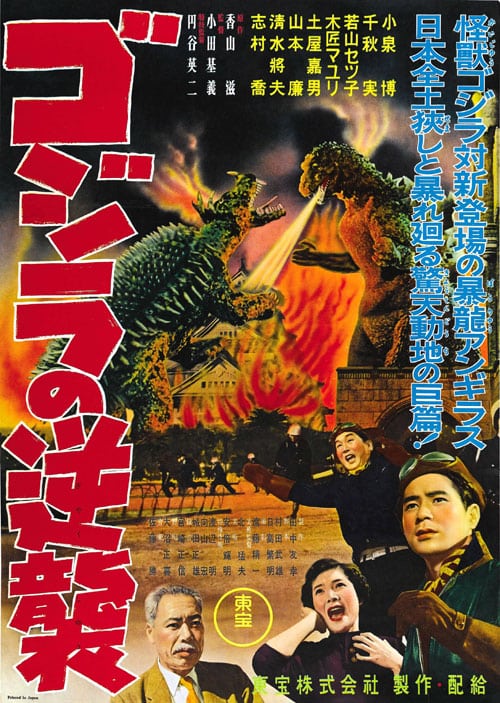
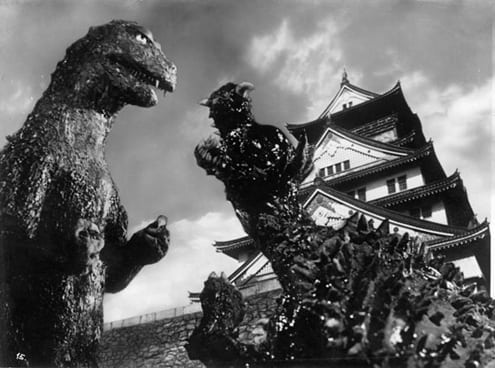
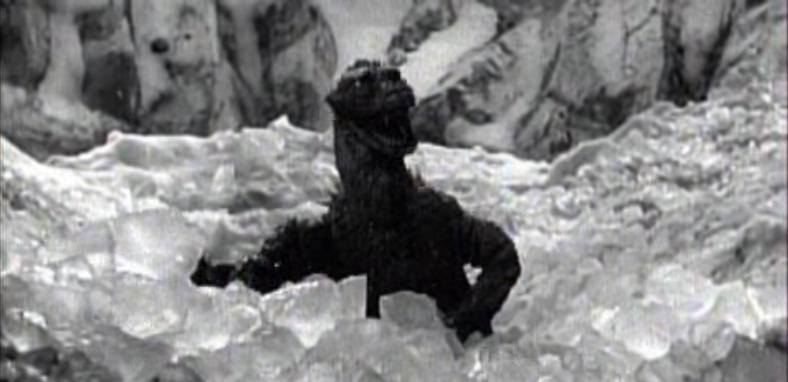
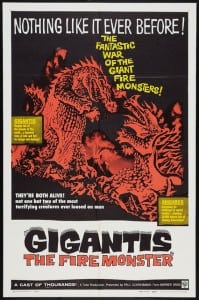

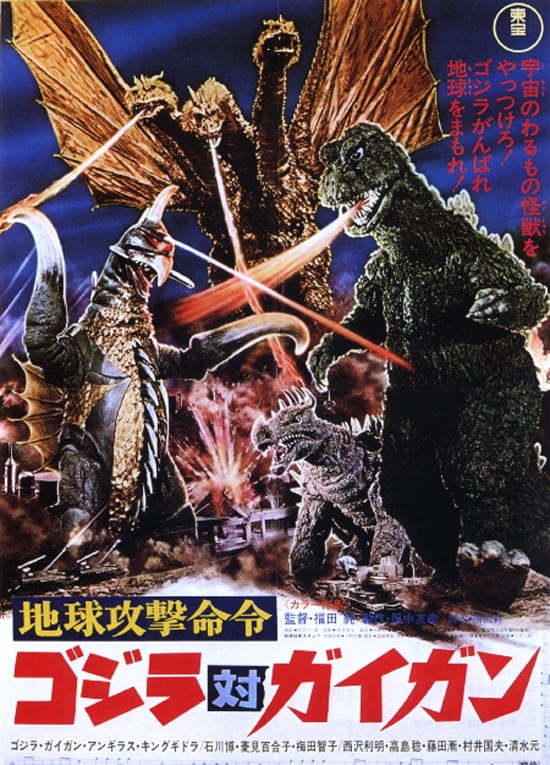
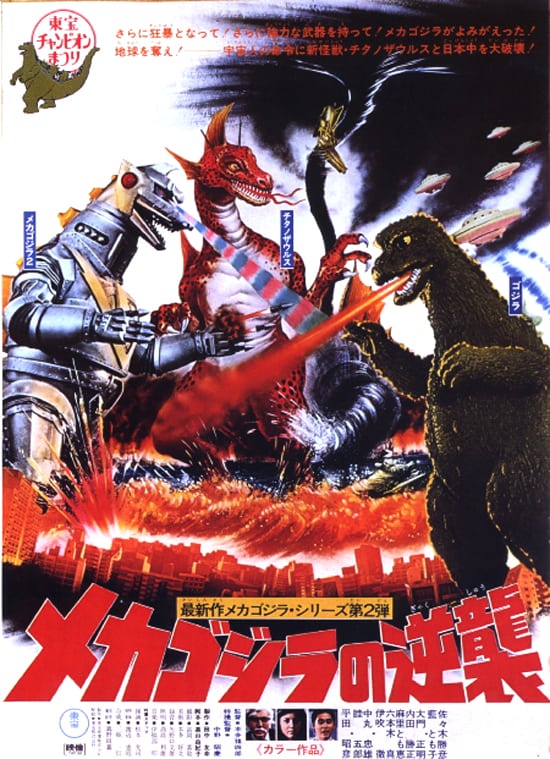
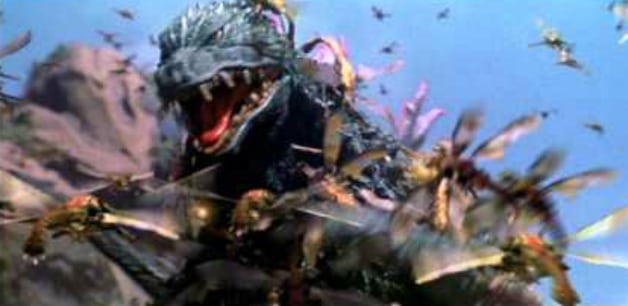
Be the first to comment